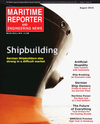
Page 84: of Maritime Reporter Magazine (August 2016)
The Shipyard Edition
Read this page in Pdf, Flash or Html5 edition of August 2016 Maritime Reporter Magazine
car industry, but of course they are not willing to pay Land-based stationary power plants operating on as two 8V engines for a ferry for Lake Constance.
too much. To reduce investment costs for hybrid sys- gas have been supplied for more than 10 years. On “We did a study to decide if dual-fuel or a pure tems we need to predevelop those systems, to reduce display at the CIMAC booth was the ? rst MTU gas gas engine is the right for us. One has to remember risks and the cost of components. Then we can come engine to run on Compressed Natural Gas based on that we do not deliver solutions for big oceangoing
PROPULSION up with a better portfolio of a pre-tested system,” he the company’s ECOtug development project. The vessels. We deliver solutions for inland waterways, said. The yachting industry, he noted, is very eager 2,000kW engine is based on the 16 cylinder Series harbors and coastal applications. In these areas, we to have these hybrid systems provided, as is also the 4000M63 diesel engine. It is to be delivered in the believe in some years gas will be there. Secondly, if commercial marine side, “as you can reduce life-cy- beginning of next year for a Svitzer-owned tug boat the infrastructure is there, a pure-gas engine does not cle costs with a hybrid system, for example in tug currently being developed by Damen Shipyards. Two have to compromise regarding ef? ciency. Also the boats and patrol boats.” 16V engines in a gas electric system has been ordered dynamic behavior is very close to that of a diesel en-
On the marine side, gas engines are new for MTU. for two catamaran ferries for Rederij Doeksen as well gine and the ef? ciency is good.”
Caterpillar
Going Dual Fuel
Maritime Reporter & Engineering News talked with most recent addition, the M 34 DF, will be in ser- medium speed engine for EPA Tier 4. “We now ap-
Andeas Banck, the Engineering Manager in charge vice in late summer, as auxiliary engines for a ferry ply this solution for all our engines, scaled up for the of Engineering, New Technology Introduction and being built in Flensburg. The diesel engines in the larger ones. The certi? cation for this equipment will
Performance & Simulation at Caterpillar Motoren in portfolio range from the M 20 C engine up to the VM be done at our factory within this year after which we
Kiel. When Stena’s technical director Harry Roberts- 43 C engine, in all eight types with an engine out- can supply SCR installations.” Banck said that Cat- son turned talk to biofuel, Banck said he did not think put from 1,020kW up to 16,800kW. “There will be erpillar Motoren has also developed EGR solutions. that there would be enough biofuels in 2030 to drive another dual fuel engine, the M 27 DF, available in “But the sulfur in the fuel causes major problems all shipping worldwide. “But there will be many new two years,” Banck said. The current references also here, even with the 0.1 percent sulfur fuel, causing fuels also available, such as methanol.” include a number of tankers and the cruise ship AID- clogging and corrosion, so we decided not to offer
Caterpillar is in the process of converting its entire Aprima, ? tted also with one MaK VM 46 DF engine. this for our marine solutions.” Another technology range of medium speed MaK engines to dual fuel. “In “For the Tier III emission regulations we have two he points out is their Part Load Optimization Tech- the marine business we think that dual fuel engines solutions, the dual fuel engines running on gas, and nology, developed during the last recent years and will be the solution for IMO Tier III. With gas you the SCR after treatment which can be applied to all now being introduced on ships, aims at boosting fuel can ful? ll the emission limits and gas is a sulfur-free our engines.” He said there are customers asking for consumption over a wide load range. It uses ? exible fuel.” At CIMAC MaK displayed its dual fuel marine both systems. “The customers are not sure if they will camshaft and waste gate technologies as well as the engines M 34 DF, M 46 DF and VM 46 DF providing get LNG all over the world.” The Cat SCR System possibility to use cylinder bypass valves in variable a power ranging from 3,060kW up to 15,440kW. The is being developed initially in the U.S. for the C 280 speed applications.
Caterpillar is in the process of converting its entire range of medium speed MaK en- gines to dual fuel. “In the ma- rine business we think that dual fuel engines will be the solution for IMO Tier III.
Andeas Banck, Engineering,
New Technology Introduction and
Performance & Simulation,
Caterpillar Motoren (Photo: Henrik Segercrantz) 84 Maritime Reporter & Engineering News • AUGUST 2016
MR #8 (82-89).indd 84 8/1/2016 4:20:25 PM

 83
83

 85
85
